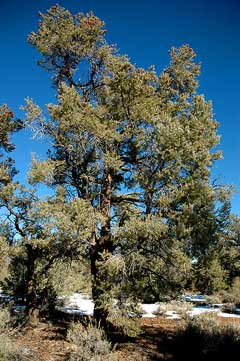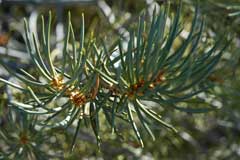 |
|
http://www.flickr.com/photos/cwsteeds/ |
 |
| http://www.flickr.com/photos/cwsteeds/ |
Translate this page:
Summary
Bloom Color: Red, Yellow. Main Bloom Time: Early spring, Late spring, Mid spring. Form: Pyramidal, Rounded.
Physical Characteristics

 Pinus_monophylla is an evergreen Tree growing to 10 m (32ft 10in) at a slow rate.It is in leaf all year, and the seeds ripen in October. The species is monoecious (individual flowers are either male or female, but both sexes can be found on the same plant) and is pollinated by Wind. The plant is not self-fertile.
Pinus_monophylla is an evergreen Tree growing to 10 m (32ft 10in) at a slow rate.It is in leaf all year, and the seeds ripen in October. The species is monoecious (individual flowers are either male or female, but both sexes can be found on the same plant) and is pollinated by Wind. The plant is not self-fertile.
Suitable for: light (sandy) and medium (loamy) soils, prefers well-drained soil and can grow in nutritionally poor soil. Suitable pH: mildly acid and neutral soils. It cannot grow in the shade. It prefers dry or moist soil and can tolerate drought.
UK Hardiness Map
US Hardiness Map
Synonyms
P. cembroides monophylla.
Plant Habitats
Edible Uses
Seed - raw or cooked[1, 82, 161, 257]. Oily, with an agreeable almond-like flavour[2, 229], they are often used in sweetmeats, pastries, etc. They are the lowest in protein and fats and the highest in starch of the piñons[183, 200]. The seeds are an important food source for the local Indians of Nevada and California[82]. A good size, the seed is up to 20mm long[200] and has a thin shell[229]. The pitch obtained from the trunk is allowed to harden and is then used as a chewing gum[257]. A vanillin flavouring is obtained as a by-product of other resins that are released from the pulpwood[200].
References More on Edible Uses
Medicinal Uses
Plants For A Future can not take any responsibility for any adverse effects from the use of plants. Always seek advice from a professional before using a plant medicinally.
Single leaf piñon was employed medicinally by several native North American Indian tribes who valued it especially for its antiseptic and vulnerary properties and also for its beneficial effect on the respiratory system[257]. It is little, if at all, used in modern herbalism. The turpentine obtained from the resin of all pine trees is antiseptic, diuretic, rubefacient and vermifuge[4]. It is a valuable remedy in the treatment of kidney and bladder complaints, and is used both internally and externally to treat rheumatic affections[4, 257]. It is also used in treating diseases of the mucous membranes, respiratory complaints, VD, TB, coughs, colds and influenza[4, 257]. A decoction is used to rid the body of tapeworms and other internal parasites[257]. Externally it is used in the form of liniment plasters and inhalers[4]. A poultice of the melted gum has been applied to cuts and sores[257]. The heated pitch has been applied to the face as a depilatory[257]. The pitch has also been used as a face cream to prevent sunburn[257]. The heated pitch has been used as a poultice to treat sciatic pains and muscular soreness[257]. The cooked pitch has been used by women to stop menstruation and thereby become infertile[257]. It has also been given to adolescent girls to help them keep youthful and live a long life[257]. The gum is used as a plaster on sores and cuts[216].
References More on Medicinal Uses
The Bookshop: Edible Plant Books
Our Latest books on Perennial Plants For Food Forests and Permaculture Gardens in paperback or digital formats.

Edible Tropical Plants
Food Forest Plants for Hotter Conditions: 250+ Plants For Tropical Food Forests & Permaculture Gardens.
More

Edible Temperate Plants
Plants for Your Food Forest: 500 Plants for Temperate Food Forests & Permaculture Gardens.
More

More Books
PFAF have eight books available in paperback and digital formats. Browse the shop for more information.
Shop Now
Other Uses
A tan or green dye is obtained from the needles[168]. The needles contain a substance called terpene, this is released when rain washes over the needles and it has a negative effect on the germination of some plants, including wheat[201]. Oleo-resins are present in the tissues of all species of pines, but these are often not present in sufficient quantity to make their extraction economically worthwhile[64]. The resins are obtained by tapping the trunk, or by destructive distillation of the wood[4, 64]. In general, trees from warmer areas of distribution give the higher yields[64]. Turpentine consists of an average of 20% of the oleo-resin[64] and is separated by distillation[4, 64]. Turpentine has a wide range of uses including as a solvent for waxes etc, for making varnish, medicinal etc[4]. Rosin is the substance left after turpentine is removed. This is used by violinists on their bows and also in making sealing wax, varnish etc[4]. Pitch can also be obtained from the resin and is used for waterproofing, as a wood preservative etc. The gum (this almost certainly means the resin[K]) is used in waterproofing canoes, baskets, water containers etc, for repairing pottery vessels and in making turquoise mosaic[216]. It is also used as an adhesive for mending pottery[257]. The bark has been used as a roofing material in houses[257]. Wood - light, soft, weak and brittle[82]. Used primarily for fuel and fence posts[229]. It is also made into charcoal and used for smelting[82]. The wood has a high combustibility and burns well[257]. It gives off a pleasant aroma as it burns[257].
Special Uses
References More on Other Uses
Cultivation details
Landscape Uses:Specimen, Woodland garden. Thrives in a light well-drained sandy or gravelly loam[1, 11]. Succeeds in a hot dry position[200]. Dislikes poorly drained moorland soils[1]. Established plants tolerate drought[200]. A slow growing tree in the wild, taking 25 years from sowing until it produces a crop[117]. It then usually produces cones annually, with heavy crops very 2 - 3 years[229]. The tree is long-lived, taking 250 - 350 years to reach maturity[181]. It grows well in southern England[120] and in most of the drier parts of Britain[11]. The cones take 2 summers to mature[229], they open and shed their seed whilst still attached to the tree[226]. Closely related to P. cembroides and considered to be no more than a sub-species of it by some botanists[11]. The main difference is that this species has its leaves singly whilst P. cembroides has them in groups of two or three[200]. Plants are strongly outbreeding, self-fertilized seed usually grows poorly[200]. They hybridize freely with other members of this genus[200]. Leaf secretions inhibit the germination of seeds, thereby reducing the amount of plants that can grow beneath the tree[18]. Plants in this genus are notably susceptible to honey fungus[200]. Special Features:
North American native, Inconspicuous flowers or blooms.
References Carbon Farming Information and Carbon Sequestration Information
Temperature Converter
Type a value in the Celsius field to convert the value to Fahrenheit:
Fahrenheit:
The PFAF Bookshop
Plants For A Future have a number of books available in paperback and digital form. Book titles include Edible Plants, Edible Perennials, Edible Trees,Edible Shrubs, Woodland Gardening, and Temperate Food Forest Plants. Our new book is Food Forest Plants For Hotter Conditions (Tropical and Sub-Tropical).
Shop Now
Plant Propagation
It is best to sow the seed in individual pots in a cold frame as soon as it is ripe if this is possible otherwise in late winter. A short stratification of 6 weeks at 4°c can improve the germination of stored seed[80]. Plant seedlings out into their permanent positions as soon as possible and protect them for their first winter or two[11]. Plants have a very sparse root system and the sooner they are planted into their permanent positions the better they will grow[K]. Trees should be planted into their permanent positions when they are quite small, between 30 and 90cm[200]. We actually plant them out when they are about 5 - 10cm tall. So long as they are given a very good weed-excluding mulch they establish very well[K]. Larger trees will check badly and hardly put on any growth for several years. This also badly affects root development and wind resistance[200]. Cuttings. This method only works when taken from very young trees less than 10 years old. Use single leaf fascicles with the base of the short shoot. Disbudding the shoots some weeks before taking the cuttings can help. Cuttings are normally slow to grow away[81].
Other Names
If available other names are mentioned here
Native Range
NORTHERN AMERICA: United States (Idaho (southeast), Arizona (northwest), California (c. & s.), Nevada, Utah), Mexico (Baja California (Norte))
Weed Potential
Right plant wrong place. We are currently updating this section.
Please note that a plant may be invasive in one area but may not in your area so it’s worth checking.
Conservation Status
IUCN Red List of Threatened Plants Status :

Growth: S = slow M = medium F = fast. Soil: L = light (sandy) M = medium H = heavy (clay). pH: A = acid N = neutral B = basic (alkaline). Shade: F = full shade S = semi-shade N = no shade. Moisture: D = dry M = Moist We = wet Wa = water.
Expert comment
Author
Torr.&Frém.
Botanical References
1182200
Links / References
For a list of references used on this page please go here
Readers comment
© 2010, Plants For A Future. Plants For A Future is a charitable company limited by guarantee, registered in England and Wales. Charity No. 1057719, Company No. 3204567.